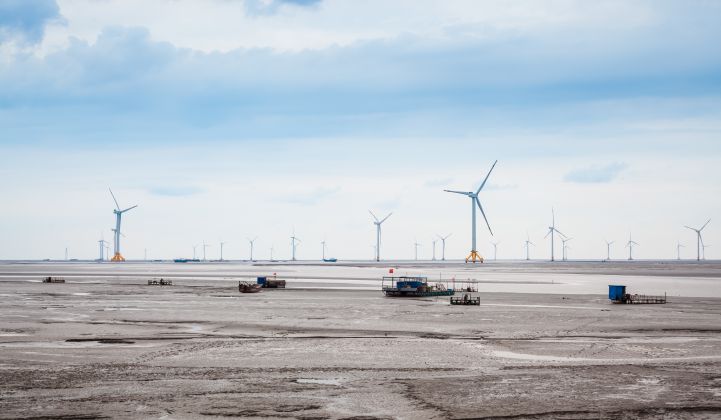China's offshore wind manufacturers could become the world's leading suppliers, even if they fail to break out of their own domestic market.
The potential size of China's surging offshore wind market means that, despite having less advanced technology than their Western peers, Chinese original equipment manufacturers could lead the global offshore wind order rankings in years to come, said Luke Lewandowski, director at Wood Mackenzie Power & Renewables.
China is expected to install around 40 gigawatts of offshore wind capacity over the next 10 years, only 11 gigawatts less than the whole of Europe.
Still, the prospect of Chinese OEMs overtaking current market leaders MHI Vestas and Siemens Gamesa Renewable Energy on the broader global stage look hazy at best.
“The Chinese manufacturers will be pretty much restricted to the Chinese market for the foreseeable future,” Lewandowski said.
There are two main reasons for this, he said. First, the enormous size of offshore wind turbines increasingly demands localized manufacturing, which Chinese OEMs might find hard to establish outside of China.
Second, and more importantly, is technology. Chinese manufacturers have yet to achieve the turbine sizes now offered by European OEMs, such as the 9.5-megawatt machines that MHI Vestas will be supplying to Vineyard Wind's 800-megawatt project off the southern coast of Massachusetts, or the 8-megawatt turbines Siemens Gamesa is selling into Taiwan.
In contrast, China's Goldwind, which is a top-five global offshore wind OEM on the strength of its Chinese order book, is touting 6.7-megawatt turbines. Sewind Shanghai, also in the top five, is offering 3.6-megawatt machines, although it also provides the Siemens-Gamesa 8-megawatt product under license.
Outside China, turbine size is a critical factor in offshore wind farm economics, to the extent that offshore wind laggard GE has put practically all its efforts into developing a 12-megawatt product, the Haliade-X, which has already attracted the attention of European utility Vattenfall.
As it stands, though, Chinese manufacturers do not really need to compete abroad in order to stay in business. With China being the world’s biggest offshore wind market by far, there is plenty to go around, particularly since the country remains a closed shop for foreign players.
Industry dynamics in China alongside the market's enormous potential mean there are more OEMs competing for business in China than there are in any other offshore market in the world. Whereas in practice almost all non-Chinese projects are now served by either Siemens Gamesa or MHI Vestas, in China there could easily be half a dozen bidders for any given plant.
Picking long-term winners from this pack is not easy, as OEMs in China often benefit from offshore wind programs in the region they come from, which makes for a shifting picture.
It is also unclear whether the Chinese offshore OEM ecosystem will be affected by consolidation.
Lower-tier onshore turbine manufacturers have already gone through a process of consolidation in the country, and many of those competing in the offshore arena are ones that have survived that cull.
Hence, while it seems likely that a Chinese company could at some point overtake MHI Vestas and Siemens Gamesa, it is hard to say which player could achieve that feat.
According to a Wood Mackenzie Power & Renewables report released last month, five Chinese OEMs ranked in the top 10 globally for order intake capacity in the first quarter of this year, perhaps an unsurprising finding given the level of consolidation among manufacturers elsewhere.
China’s offshore market grew by 66 percent year-on-year, the analyst firm said. This led to a record first quarter for Chinese offshore wind turbine orders, with 1.7 gigawatts of capacity being sold.
Five Chinese OEMs each carried off more than 300 megawatts of offshore orders, with 77 percent of all the capacity worldwide going to companies in China. In contrast, offshore orders fell by 55 percent year on year in Europe.
There was only one major European offshore project, a 487-megawatt plant in Belgium, seeking turbines in the first quarter of this year, Wood Mackenzie said.




